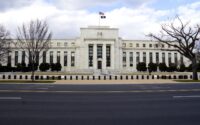Subzero Rate Copied the World Over Is About to End in Denmark
(Bloomberg) — The world’s original and longest-running experiment in negative interest rates will finally end this week as Denmark raises borrowing costs in tandem with the euro zone.
Most Read from Bloomberg
The move is likely as the European Central Bank delivers a large hike on Thursday, because Danish monetary policy often shadows such moves to protect the krone’s peg to the single currency.
The country is now left nursing the consequences of a decade-long era of ultra-cheap money, including inflated asset prices that may yet threaten financial stability.
“The economy will be facing problems,” Karen Frosig, chief executive officer of Sydbank A/S, Denmark’s third-largest listed lender, said in an interview. “Negative rates have created some negative effects, including bubbles, and this is probably in all asset classes: real estate, the stock market and corporate deals.”
Denmark’s foray below zero in 2012, intended to deter investors from buying the krone, challenged notions of how to price money and inspired central bankers seeking new stimulus methods.
Neighbors in Sweden and the euro zone went negative too along with Switzerland and Japan. In 2019 and 2020, the Federal Reserve resisted pressure from then-US President Donald Trump to join them.
With the ECB now already at zero and poised to hike by as much as 75 basis points, eight economists polled by Bloomberg News predict Nationalbanken will raise its current-account rate from -0.1%.
Frosig at Sydbank reckons Denmark’s exit should be “a day of celebration” because subzero rates strained banks, which shielded depositors from the costs for most of the duration.
That moment coincides with the departure of the policy’s front man, after Lars Rohde announced last week his retirement in January following a decade as central-bank governor.
Market exuberance during his tenure has been noticeable. House prices jumped 56% in the decade through the first quarter, compared with 41% in the euro area. There have been signs of a correction, though Copenhagen’s benchmark stock index is still up 207% in the 10-year period, compared with 54% for the Stoxx Europe 600 Index.
“Negative rates have been fanning the overheating,” said Jan Storup Nielsen, chief analyst at Nordea. “There will be a price to pay.”
The policy led to perverse effects. Even home-loan costs ultimately went below zero for some borrowers, and in 2019, Jyske Bank A/S issued 10-year covered bonds at a negative coupon. When banks did start charging negative rates on retail depositors, wealthy Danes rushed to buy safes to store cash at home instead.
But with the central bank’s mission solely to focus on the euro peg — it doesn’t have an inflation target — officials doggedly stuck with the experiment.
By contrast, the side effects were too onerous for Sweden’s central bank, which was the first to end the policy in December 2019. Even then, Riksbank Deputy Governor Anna Breman mused last year on the theoretical possibility of “deeply negative” rates — such as -5% — previously considered by economists such as Ken Rogoff.
The euro area stuck with negative rates until July. By then the policy had long been deeply unpopular in Germany, the region’s biggest economy.
Even if a quicker exit might have been preferable, Danish subzero rates indirectly helped by letting exporters and foreign investors count on a stable currency.
“Denmark showed that it was physically possible,” Nordea’s Storup Nielsen said. “It may be seen as a given now, but 10 years ago there was concern whether financial systems could even operate with negative rates.”
Most Read from Bloomberg Businessweek
©2022 Bloomberg L.P.
[ad_2]
Source link


